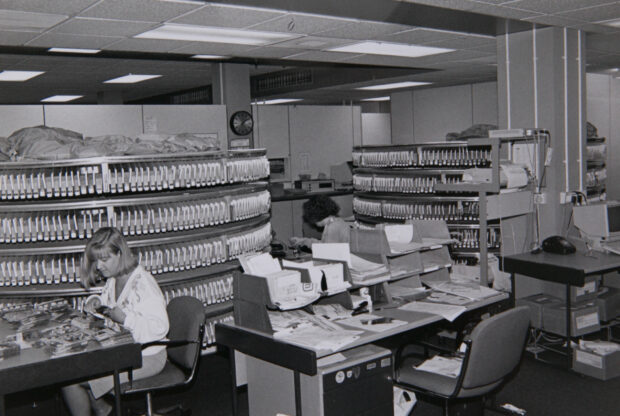This year marks 40 years since we moved our head quarters from London to Cardiff. We look at our milestones over those years, alongside worldwide technology developments.
1976
In the same year that the Queen sends her first email on the precursor to the internet, Arpanet, we relocate our HQ from London to Cardiff. In this year, we start microfilming documents: creating microfiche copies of new paper documents. Also in 1976, Apple is formed in America by Steve Jobs and Steve Wozniak.

1980
Companies Act 1980 was introduced. This year Tim Berners-Lee starts working on ENQUIRE, the system that will eventually lead to the creation of the world wide web, something a few of us are fond of now.
1981
Another Companies Act was introduced (Companies Act 1981, surprisingly enough). Also in this year, Apple (UK) Limited was incorporated with us. You can find the company details on our service, along with Steve Jobs’ signature as shareholder (although he’s down as Steven Jobs).

1985
In 1985 we introduce Stem, our first computerised information processing system. This year the first UK mobile phone network was launched by Vodafone, and for the first 9 days of the year was the only company with a mobile network in the UK. Vodafone incorporated with us in 1980, see their entry on the Companies House Service.
1990
This year we opened regional offices in Manchester, Birmingham and Leeds. And in the same year Tim Berners-Lee had defined the web’s basic concepts such as: URL, http and html, and he had written the first browser and server software. So we were all making a difference.
1995
Digital scanners are introduced in Companies House – it’s the future! Also this year Microsoft launches its operating system, Windows 95, bringing new functions such as the task bar and Start menu. To install Windows 95 it took 13 floppy disks (ask your parents, kids), but as painstaking as this was it redefined home computing. Exciting times?
1997
In 1997 we introduce Companies House Direct (CHD): our first online search system, our website was launched this year, too – thanks Tim Berners-Lee. Aside from our website and CHD, other major tech developments include IBM's computer, Deep Blue, beating the human world chess champion, Gary Kasparov. Look out humans.
1998
This year saw the introduction of e-filing directors and annual return forms. Also, Google is incorporated in America by co-founders Larry Page and Sergey Brin; their office? A garage, in Menlo Park, California, handling 10,000 queries a day.

2000
In 2000 we introduce WebCHeck online search provisions aimed at smaller, casual users. Google UK Limited was also incorporated with us this year, you can see Sergey Brin’s appointment of director form.
2001
This year WebFiling goes live, and electronic incorporations commence. Also, Apple introduces iPod. The Walkman generation were amazed at the whopping 1000 songs they could keep in their pocket (and the streaming gen wonder what the fuss is about).

2002
2002 saw us stopping updates to microfiche (it had a good run). More than 60% of all live companies in this year have a full electronic record. Elsewhere, the first robot vacuum cleaner to hit the markets, Roomba, is released. The company that make the Roomba, iRobot, was founded by three MIT grads who previously designed war robots.
2003
Due to technical advances, we close our regional offices in Manchester, Leeds and Birmingham. Also in 2003, more technical advances were witnessed as the human genome project was completed, successfully sequencing the human genome.
2006
The Companies Act 2006 receives Royal Assent (Implemented in October 2009). In the same year, Twitter was launched, here’s the first ever tweet by Twitter’s co-founder Jack Dorsey. We can’t believe it’s in double digits.
just setting up my twttr
— ??jack (@jack) March 21, 2006
2008
We implement the Companies House information processing system (CHIPS). This system replaces our then 20-year-old electronic processing system, Stem. Surely on par with our new system, the world’s most powerful particle collider, the Large Hadron Collider, starts accelerating particles so scientists can attempt to understand fundamental questions about the universe.

2015
We provide the public with free access to all digital data free of charge via the Companies House Service (CHS) and an application program interface (API). Some 170 million company records were available free for the first time. And breakthrough technologies last year include nano-architecture (structures that seemingly defy physics), brain organoids (method for growing human brain cells), and Google’s Loon Project (potentially providing internet access to billions).
2016
Company data continues to grow on CHS. We're currently fulfilling around 14 million search requests per day: 5 million using CHS, 9 million via the API. The biggest peak for us was in April this year with a combined 16 million searches in one day. Who knows what the next 40 years will bring. Although Google’s director of engineering thinks we’ll have merged with machines before then, rest assured, we’ll be sticking to digital registers. Or will we?
To keep in touch, sign up to email updates from this blog, or follow us on Twitter.
